fuel pressure CHEVROLET KODIAK 2008 Owners Manual
[x] Cancel search | Manufacturer: CHEVROLET, Model Year: 2008, Model line: KODIAK, Model: CHEVROLET KODIAK 2008Pages: 384, PDF Size: 5.4 MB
Page 81 of 384
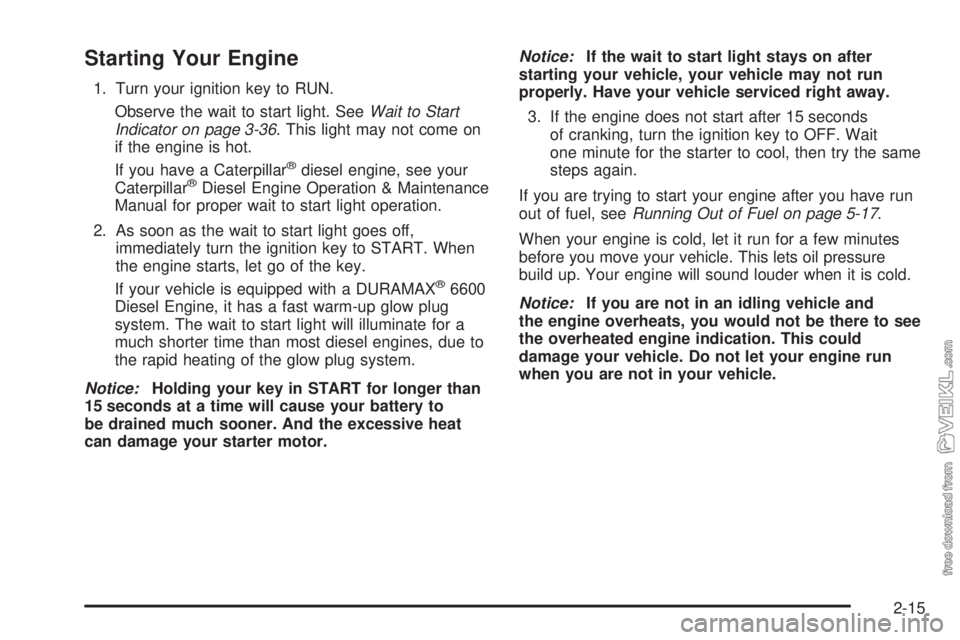
Starting Your Engine
1. Turn your ignition key to RUN.
Observe the wait to start light. SeeWait to Start
Indicator on page 3-36. This light may not come on
if the engine is hot.
If you have a Caterpillar
®diesel engine, see your
Caterpillar®Diesel Engine Operation & Maintenance
Manual for proper wait to start light operation.
2. As soon as the wait to start light goes off,
immediately turn the ignition key to START. When
the engine starts, let go of the key.
If your vehicle is equipped with a DURAMAX
®6600
Diesel Engine, it has a fast warm-up glow plug
system. The wait to start light will illuminate for a
much shorter time than most diesel engines, due to
the rapid heating of the glow plug system.
Notice:Holding your key in START for longer than
15 seconds at a time will cause your battery to
be drained much sooner. And the excessive heat
can damage your starter motor.Notice:If the wait to start light stays on after
starting your vehicle, your vehicle may not run
properly. Have your vehicle serviced right away.
3. If the engine does not start after 15 seconds
of cranking, turn the ignition key to OFF. Wait
one minute for the starter to cool, then try the same
steps again.
If you are trying to start your engine after you have run
out of fuel, seeRunning Out of Fuel on page 5-17.
When your engine is cold, let it run for a few minutes
before you move your vehicle. This lets oil pressure
build up. Your engine will sound louder when it is cold.
Notice:If you are not in an idling vehicle and
the engine overheats, you would not be there to see
the overheated engine indication. This could
damage your vehicle. Do not let your engine run
when you are not in your vehicle.
2-15
Page 84 of 384
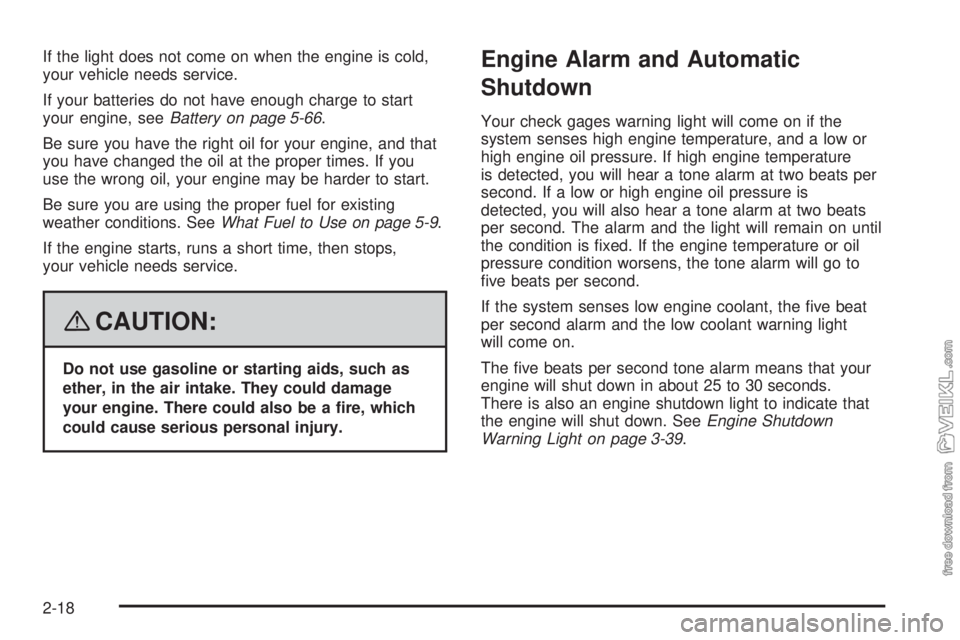
If the light does not come on when the engine is cold,
your vehicle needs service.
If your batteries do not have enough charge to start
your engine, seeBattery on page 5-66.
Be sure you have the right oil for your engine, and that
you have changed the oil at the proper times. If you
use the wrong oil, your engine may be harder to start.
Be sure you are using the proper fuel for existing
weather conditions. SeeWhat Fuel to Use on page 5-9.
If the engine starts, runs a short time, then stops,
your vehicle needs service.
{CAUTION:
Do not use gasoline or starting aids, such as
ether, in the air intake. They could damage
your engine. There could also be a �re, which
could cause serious personal injury.
Engine Alarm and Automatic
Shutdown
Your check gages warning light will come on if the
system senses high engine temperature, and a low or
high engine oil pressure. If high engine temperature
is detected, you will hear a tone alarm at two beats per
second. If a low or high engine oil pressure is
detected, you will also hear a tone alarm at two beats
per second. The alarm and the light will remain on until
the condition is fixed. If the engine temperature or oil
pressure condition worsens, the tone alarm will go to
five beats per second.
If the system senses low engine coolant, the five beat
per second alarm and the low coolant warning light
will come on.
The five beats per second tone alarm means that your
engine will shut down in about 25 to 30 seconds.
There is also an engine shutdown light to indicate that
the engine will shut down. SeeEngine Shutdown
Warning Light on page 3-39.
2-18
Page 122 of 384
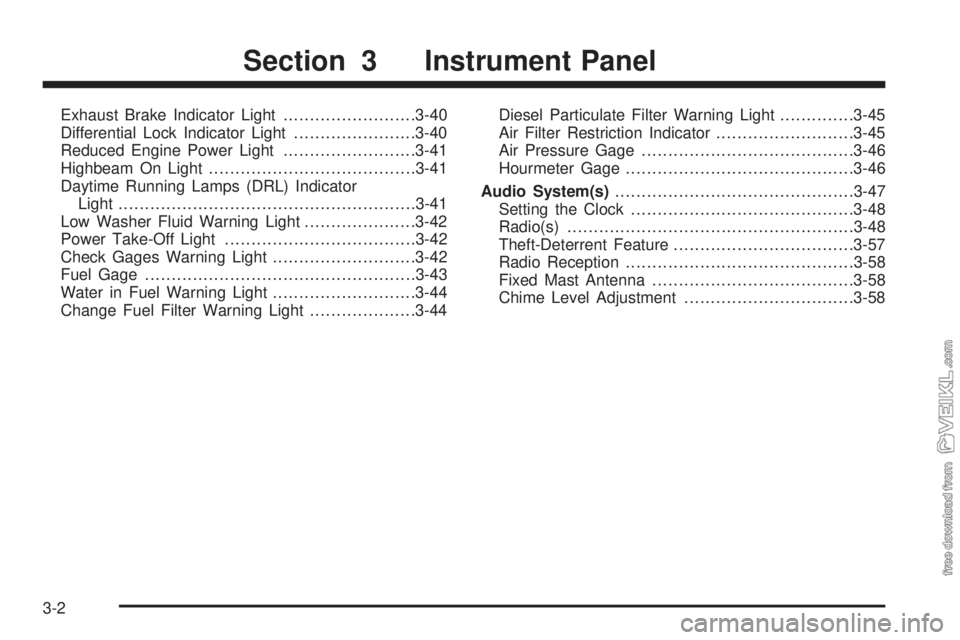
Exhaust Brake Indicator Light.........................3-40
Differential Lock Indicator Light.......................3-40
Reduced Engine Power Light.........................3-41
Highbeam On Light.......................................3-41
Daytime Running Lamps (DRL) Indicator
Light........................................................3-41
Low Washer Fluid Warning Light.....................3-42
Power Take-Off Light....................................3-42
Check Gages Warning Light...........................3-42
Fuel Gage...................................................3-43
Water in Fuel Warning Light...........................3-44
Change Fuel Filter Warning Light....................3-44Diesel Particulate Filter Warning Light..............3-45
Air Filter Restriction Indicator..........................3-45
Air Pressure Gage........................................3-46
Hourmeter Gage...........................................3-46
Audio System(s).............................................3-47
Setting the Clock..........................................3-48
Radio(s)......................................................3-48
Theft-Deterrent Feature..................................3-57
Radio Reception...........................................3-58
Fixed Mast Antenna......................................3-58
Chime Level Adjustment................................3-58
Section 3 Instrument Panel
3-2
Page 199 of 384
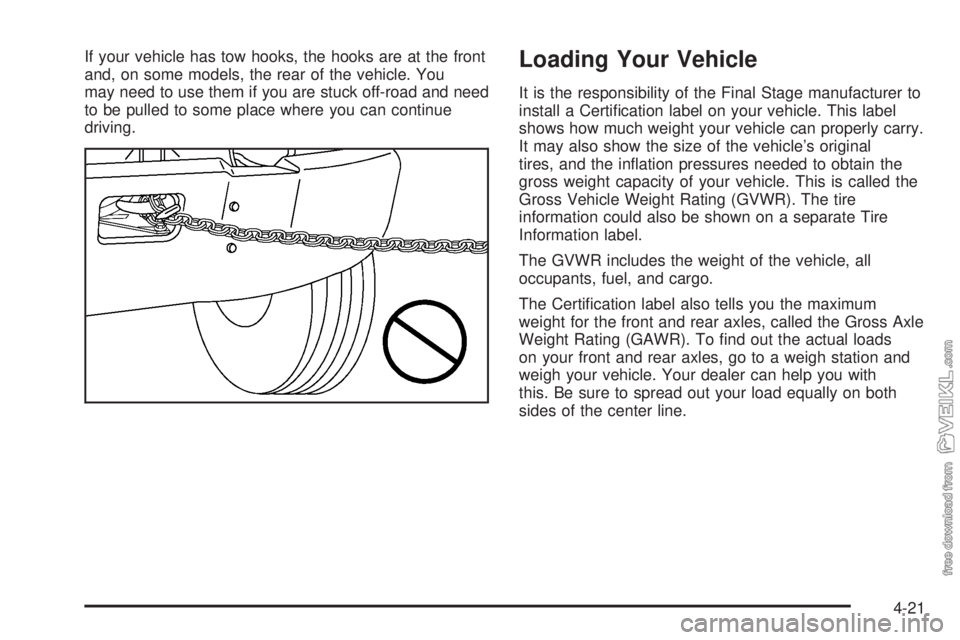
If your vehicle has tow hooks, the hooks are at the front
and, on some models, the rear of the vehicle. You
may need to use them if you are stuck off-road and need
to be pulled to some place where you can continue
driving.Loading Your Vehicle
It is the responsibility of the Final Stage manufacturer to
install a Certification label on your vehicle. This label
shows how much weight your vehicle can properly carry.
It may also show the size of the vehicle’s original
tires, and the inflation pressures needed to obtain the
gross weight capacity of your vehicle. This is called the
Gross Vehicle Weight Rating (GVWR). The tire
information could also be shown on a separate Tire
Information label.
The GVWR includes the weight of the vehicle, all
occupants, fuel, and cargo.
The Certification label also tells you the maximum
weight for the front and rear axles, called the Gross Axle
Weight Rating (GAWR). To find out the actual loads
on your front and rear axles, go to a weigh station and
weigh your vehicle. Your dealer can help you with
this. Be sure to spread out your load equally on both
sides of the center line.
4-21
Page 205 of 384

Service............................................................5-4
Accessories and Modifications..........................5-4
California Proposition 65 Warning.....................5-5
California Perchlorate Materials Requirements.....5-5
Doing Your Own Service Work.........................5-6
Engine Fan Breakage.....................................5-6
Fuel................................................................5-7
Gasoline Octane............................................5-7
Gasoline Specifications....................................5-7
Additives.......................................................5-8
Diesel Engine Fuel.........................................5-9
What Fuel to Use...........................................5-9
Very Cold Weather Operation.........................5-12
Water in Fuel...............................................5-12
Running Out of Fuel.....................................5-17
Fuel Filter Replacement.................................5-18
Fuels in Foreign Countries.............................5-19
Filling the Tank............................................5-20
Filling a Portable Fuel Container.....................5-21
Checking Things Under the Hood....................5-22
Hood Latches...............................................5-22
Engine Oil (Caterpillar
®Diesel Engine).............5-23
Engine Oil (Gasoline Engine)..........................5-24
Engine Oil (DURAMAX
®Diesel Engine)............5-28Engine Oil (Isuzu Diesel Engine).....................5-32
Engine Oil Life System (Gasoline Engine)........5-36
Engine Oil Life System (DURAMAX
®/Isuzu
Diesel Engines).........................................5-37
Engine Oil Life System (Caterpillar
®Diesel
Engine)....................................................5-39
Engine Air Cleaner/Filter................................5-39
Automatic Transmission Fluid.........................5-43
Manual Transmission Fluid.............................5-43
Engine Coolant (Caterpillar
®Diesel Engines).....5-44
Engine Coolant (Gas and DURAMAX®/
Isuzu 7.8L L6 Engines)..............................5-44
Coolant Surge Tank Pressure Cap..................5-47
Engine Overheating.......................................5-48
Cooling System............................................5-50
Engine Fan Noise.........................................5-54
Power Steering Fluid.....................................5-54
Windshield Washer Fluid................................5-55
Brakes........................................................5-57
Battery........................................................5-66
Jump Starting...............................................5-67
Rear Axle.......................................................5-72
Rear Axle Shift Motor....................................5-73
Section 5 Service and Appearance Care
5-1
Page 206 of 384
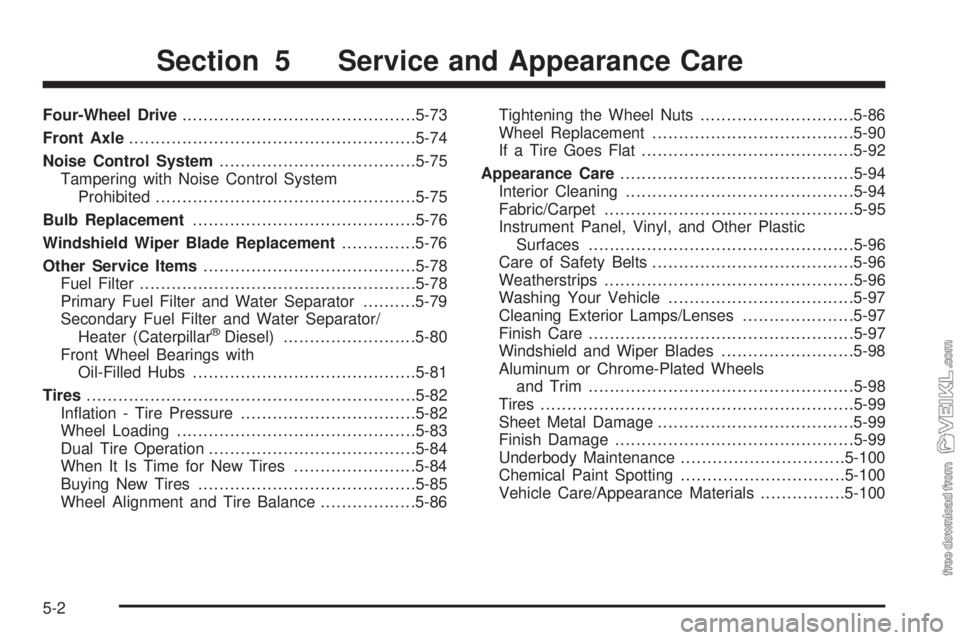
Four-Wheel Drive............................................5-73
Front Axle......................................................5-74
Noise Control System.....................................5-75
Tampering with Noise Control System
Prohibited.................................................5-75
Bulb Replacement..........................................5-76
Windshield Wiper Blade Replacement..............5-76
Other Service Items........................................5-78
Fuel Filter....................................................5-78
Primary Fuel Filter and Water Separator..........5-79
Secondary Fuel Filter and Water Separator/
Heater (Caterpillar
®Diesel).........................5-80
Front Wheel Bearings with
Oil-Filled Hubs..........................................5-81
Tires..............................................................5-82
Inflation - Tire Pressure.................................5-82
Wheel Loading.............................................5-83
Dual Tire Operation.......................................5-84
When It Is Time for New Tires.......................5-84
Buying New Tires.........................................5-85
Wheel Alignment and Tire Balance..................5-86Tightening the Wheel Nuts.............................5-86
Wheel Replacement......................................5-90
If a Tire Goes Flat........................................5-92
Appearance Care............................................5-94
Interior Cleaning...........................................5-94
Fabric/Carpet...............................................5-95
Instrument Panel, Vinyl, and Other Plastic
Surfaces..................................................5-96
Care of Safety Belts......................................5-96
Weatherstrips...............................................5-96
Washing Your Vehicle...................................5-97
Cleaning Exterior Lamps/Lenses.....................5-97
Finish Care..................................................5-97
Windshield and Wiper Blades.........................5-98
Aluminum or Chrome-Plated Wheels
and Trim..................................................5-98
Tires...........................................................5-99
Sheet Metal Damage.....................................5-99
Finish Damage.............................................5-99
Underbody Maintenance...............................5-100
Chemical Paint Spotting...............................5-100
Vehicle Care/Appearance Materials................5-100
Section 5 Service and Appearance Care
5-2
Page 258 of 384

4. With the coolant surge tank pressure cap off, start
the engine and let it run until you can feel the upper
radiator hose getting hot. Watch out for the engine
cooling fan.
By this time, the coolant level inside the coolant
surge tank may be lower. If the level is lower, add
more of the proper mixture to the coolant surge tank
until the level reaches slightly above the FULL
COLD mark.
5. Then replace the pressure cap. Be sure the
pressure cap is hand-tight and fully seated.
Engine Fan Noise
Your vehicle has a clutched engine cooling fan. When
the clutch is engaged, the fan spins faster to provide
more air to cool the engine. In most everyday driving
conditions, the clutch is not fully engaged. This improves
fuel economy and reduces fan noise. Under heavy
vehicle loading, trailer towing and/or high outside
temperatures, the fan speed increases when the clutch
engages. So you may hear an increase in fan noise. This
is normal and should not be mistaken as the transmission
slipping or making extra shifts. It is merely the cooling
system functioning properly. The fan will slow down when
additional cooling is not required and the clutch
disengages.
You may also hear this fan noise when you start the
engine. It will go away as the fan clutch disengages.
Power Steering Fluid
SeeScheduled Maintenance on page 6-5to determine
when to check your power steering fluid.
5-54
Page 282 of 384

Other Service Items
Fuel Filter
Fuel Filter/Pressure Regulator
(Gasoline Engines)
The steel fuel filter/pressure regulator is located near
the engine compartment on the driver’s side frame rail.
If your vehicle has a rear steel fuel tank, the fuel
filter/pressure regulator is located near the rear fuel tank,
on the driver’s side frame rail. SeeScheduled
Maintenance on page 6-5for recommended service
intervals.
If your vehicle is equipped with the optional Davco
spin-on type filter, it is located on the driver’s side
frame rail.
Fuel Filter (Diesel Engines)
If you have a diesel engine, your fuel filter is located in
the engine compartment on the driver’s side of the
vehicle, or along the driver’s side frame rail. See “Fuel
Filter Replacement” earlier in this section for further
information.
Also seeScheduled Maintenance on page 6-5for
recommended service intervals.
5-78
Page 287 of 384
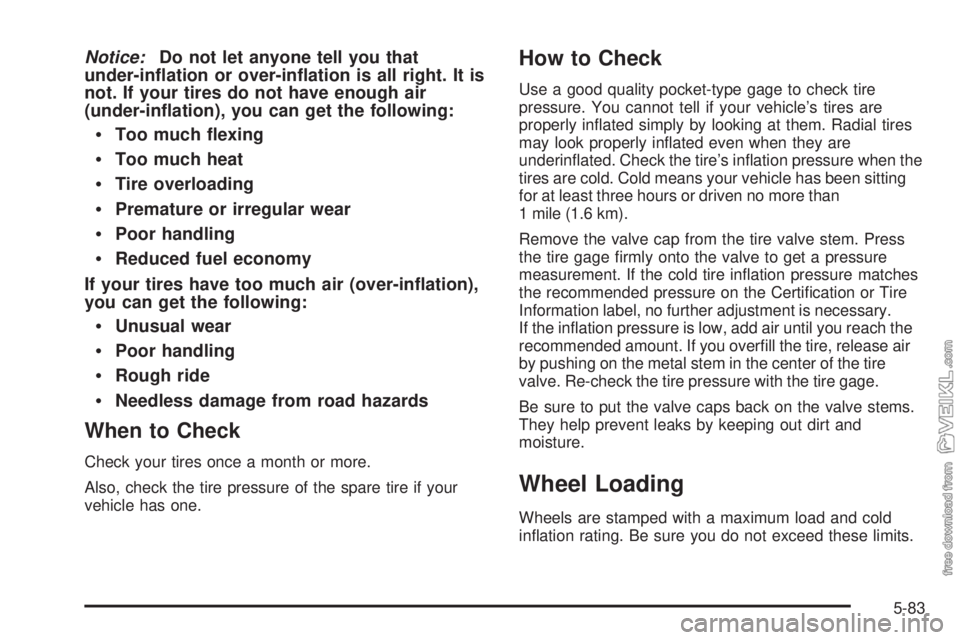
Notice:Do not let anyone tell you that
under-in�ation or over-in�ation is all right. It is
not. If your tires do not have enough air
(under-in�ation), you can get the following:
Too much �exing
Too much heat
Tire overloading
Premature or irregular wear
Poor handling
Reduced fuel economy
If your tires have too much air (over-in�ation),
you can get the following:
Unusual wear
Poor handling
Rough ride
Needless damage from road hazards
When to Check
Check your tires once a month or more.
Also, check the tire pressure of the spare tire if your
vehicle has one.
How to Check
Use a good quality pocket-type gage to check tire
pressure. You cannot tell if your vehicle’s tires are
properly inflated simply by looking at them. Radial tires
may look properly inflated even when they are
underinflated. Check the tire’s inflation pressure when the
tires are cold. Cold means your vehicle has been sitting
for at least three hours or driven no more than
1 mile (1.6 km).
Remove the valve cap from the tire valve stem. Press
the tire gage firmly onto the valve to get a pressure
measurement. If the cold tire inflation pressure matches
the recommended pressure on the Certification or Tire
Information label, no further adjustment is necessary.
If the inflation pressure is low, add air until you reach the
recommended amount. If you overfill the tire, release air
by pushing on the metal stem in the center of the tire
valve. Re-check the tire pressure with the tire gage.
Be sure to put the valve caps back on the valve stems.
They help prevent leaks by keeping out dirt and
moisture.
Wheel Loading
Wheels are stamped with a maximum load and cold
inflation rating. Be sure you do not exceed these limits.
5-83
Page 334 of 384

45,000 Miles (72 000 km)
❑Gasoline Engine Only: Check engine oil life system.
If engine oil and filter are changed, reset system.
See “Engine Oil (Gasoline Engine)” in the
Index.(2) (8)
❑DURAMAX
®/Isuzu Diesel Without Engine Oil Life
System Only: Change engine oil and filter (or
every 12 months, or every 750 hours of engine
operation, whichever occurs first).(2) (39)
❑DURAMAX
®/Isuzu Diesel With Engine Oil Life
System Only: Check oil life system. If engine oil and
filter are changed, reset system. See “Engine Oil
(DURAMAX
®/Isuzu Diesel)” in the Index.(2) (9)
❑Check fluid levels (or every 3 months, whichever
occurs first).(1) (5)
❑Gasoline Engine: Replace engine air cleaner filter.
SeeEngine Air Cleaner/Filter on page 5-39for
more information.
❑Diesel Engine: Inspect engine air cleaner filter
change indicator. If necessary, replace the filter.
If vehicle is driven in dusty/dirty conditions, inspect
filter change indicator at every engine oil change. See
Engine Air Cleaner/Filter on page 5-39for more
information.
❑DURAMAX
®/Isuzu Diesel Only: Replace fuel filter
(or every 750 hours of engine operation, whichever
occurs first).❑Chassis lubrication service (or every 6 months,
whichever occurs first).(11)
❑Cooling system service. Clean the cooling system
filler cap with clean water, clean the core, pressure
test the cap and the system for proper pressure
capability, and inspect condition of cooling and heater
hoses and clamps. Replace hoses if cracked,
swollen, or damaged.
❑Inspect door hinge pins and bushings and replace as
necessary.
❑Steering system service.(12)
❑Front and rear suspension service.(13)
❑Spring-to-axle U-bolts and shackle bolts service.(15)
❑Exhaust system service (or every 6 months,
whichever occurs first).(2) (3) (16)
❑Wheels and tires service.(14)
❑Hydraulic brake service (or every 6 months,
whichever occurs first).(6) (36)
❑Parking brake service (or every 6 months, whichever
occurs first).(21)
❑Air brake service (or every 6 months, whichever
occurs first).(32)
❑Air brake automatic slack adjuster service (or every
500 hours, whichever occurs first).(33)
6-10